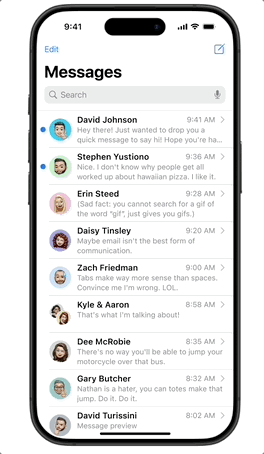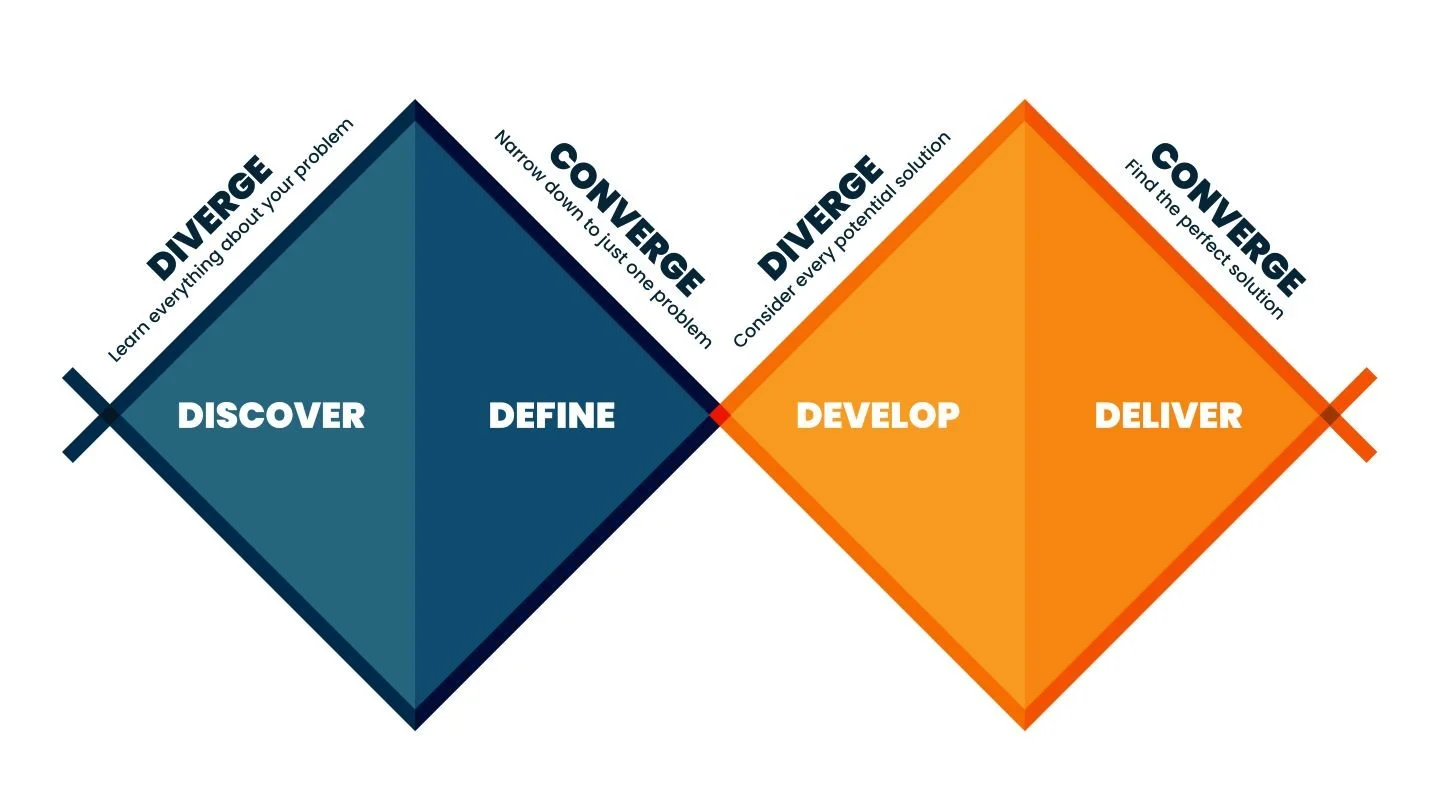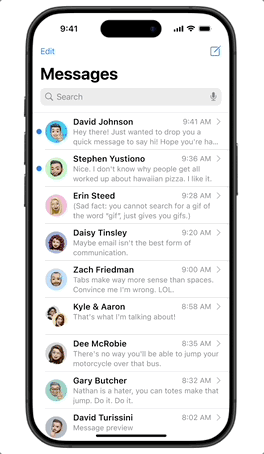iMessage
Adding a feature to iMessage’s search functionality
Type: Add a new feature
Role: UX & UI Designer and Researcher
Duration: 4 weeks
Background
While iMessage's seamless Apple integration makes it the default U.S. messaging choice, its search capability has remained a notable limitation, especially compared to alternatives like WhatsApp or Telegram. This project set out to bridge that gap: transforming iMessage search from basic to powerful.
As a frequent iMessage user, I’ve often struggled with its limited search functionality. Scrolling endlessly to find old messages, while other apps like WhatsApp make retrieval effortless. This led me to a hypothesis:
Were other users equally frustrated, or was this just my personal pain point?
Double Diamond Framework
To validate this hypothesis and design a solution that truly addressed user needs, I followed the Double Diamond framework, structuring my process to move from broad research to targeted solutions while maintaining rigorous user focus at every stage.
3. Develop
Created low-fidelity wireframes to explore new functionalities.
Conducted usability testing on early concepts to gather feedback.
Iterated on designs based on user insights.
4. Deliver (Finalization & Handoff)
Developed high-fidelity wireframes with refined UI and interactions.
Ran additional usability testing to validate improvements.
Finalized designs based on feedback and prepared for development.
1. Discover
Conducted user interviews to validate my hypothesis and understand pain points
Performed competitive analysis to identify best practices in the market
Synthesized findings to uncover key user needs and challenges.
2. Define
Developed user personas based on research insights.
Prioritized features through impact vs. effort analysis
This structured approach led me to start with user interviews and inquire about their experience with iMessage and its search functionality
User Interviews
To understand user frustrations with iMessage's current search functionality and identify opportunities to make message retrieval significantly easier and more intuitive. This research aimed to:
Uncover pain points in users' existing search workflows
Discover how search limitations impact their messaging experience
Gather expectations based on users' experiences with other communication platforms
Method:
Conducted 5 moderated 1:1 interviews with active iMessage users
Focused discussion on:
Typical scenarios when searching for past messages
Emotional responses to successful/unsuccessful searches
Workarounds developed to compensate for search limitations
Key Insights:
Fragmented discovery: Most struggled to find messages without exact keywords, resorting to endless scrolling.
Feature envy: Non-US users missed WhatsApp-style search (in-chat, pinning), while US loyalists valued simplicity over power.
Universal ask: All wanted effortless retrieval that maintained iMessage's clean aesthetic.
Research Synthesis
User Behaviors & Pain Points
Search purposes
Keyword dependency:
Users struggle when exact keywords aren’t remembered
No partial-match or semantic search support
iMessage vs. Competitors
Non-US users (4/5):
Prefer WhatsApp’s advanced features (in-chat search, filters, pinning)
Perceive iMessage as "limiting" for complex searches
US user (1/5):
Satisfied with iMessage’s simplicity but acknowledged gaps (e.g., no date filters)
Critical Frustrations
Global search limitation:
Cannot search within individual chats
Forces excessive scrolling
Media retrieval issues:
Photos/files often "disappear" from results
Lack of visibility:
Search suggestions/categories are poorly surfaced
With my hypothesis confirmed that iMessage's search frustrations were widespread, I did a competitive analysis to understand the best practices for providing a good search solutions for users
Competitive Analysis
WhatsApp (Market Leader)
In-conversation search with message previews
Media-specific filters (photos, links, docs)
Date-based filtering (+ "shared media" view)
Pinned messages with quick access
The audit of the leading messaging platforms exposed iMessage as an outlier in search capabilities:
Core Limitations:
Only basic global keyword search
No context-aware results
Media/files often excluded from results
Zero organizational tools (pinning, labeling)
Competitor Advantages:
Telegram (Power User Favorite)
Semantic search (finds related terms/concepts)
Message categorization (personal vs. group)
Saved Messages "cloud" with folders
Advanced operators (from:, to:, before:)
Slack (Enterprise Benchmark)
Natural language processing
Cross-channel search
Custom reaction-based tagging
Search history/saved queries
Strategic Insights:
The Basic-to-Power Spectrum
iMessage sat at the far "basic" end while competitors offered tiered approaches - from simple searches to power tools.The Organization Deficit
Every audited app except iMessage provided message preservation tools (pinning, starring, saving).Platform Paradox
While Apple leads in device integration, it trails in message retrieval - creating friction in their "seamless ecosystem" promise.
Moving into the Define phase, I used the user interview findings to create a primary persona. This persona captured the main frustrations and behaviors around message search, providing a clear focus for design decisions.
Persona
These insights led me into “Busy Alex”
A persona who embodied the users' core struggles and motivations. Her story became our decision filter: every design decision had to prove it would simplify Alex’s chaotic day, not add complexity.
With our persona defining the core user needs, I turned to competitive analysis to identify potential solutions. The research revealed numerous possible features, too many to implement at once. To focus the efforts, I used a impact-effort matrix to prioritize enhancements that would deliver maximum impact with feasible development costs.
Impact / Effort matrix
Through our Value/Effort matrix, we identified three implementation tiers:
1️⃣ Immediate Implementation (High Value/Low Effort)
In-chat search with message previews
Advanced filters (media type, date ranges)
Auto-suggestions (predictive search terms)
Message pinning/saving functionality
Improved media search
2️⃣ Future Roadmap (High Value/High Effort)
Voice search integration
Cross-app search integration
3️⃣ Lower Priority (Specialized Use Cases)
AI-generated search predictions
After prioritizing key features, I mapped iMessage’s core user flows to ensure my solutions felt native to existing interactions, identifying exactly where and how search enhancements would integrate without disrupting users’ mental models.
User Flow
With our persona established, key features prioritized, and user flows mapped, I transitioned into the Develop phase. Starting with low-fidelity wireframes, I began translating these research-backed requirements into tangible design concepts, focusing first on the core search functionality improvements identified as highest priority.
Low Fidelity Wireframes
I started sketching low-fi wireframes with the objective to test if the in-chat search, filters, and suggestions actually make message retrieval faster and less frustrating. These rough prototypes would help me validate the core concepts before polishing the design.
Starring / saving messages
Advanced search filters, improved media search and auto suggestions
In-chat search
Low Fi usability testing
Goal: to validate whether the new search functionalities (in-chat search, auto-suggestions, advanced filters, and starring messages) are intuitive, useful, and improve the user experience compared to the current iMessage search while still making sense for the Apple ecosystem.
Participants: 6 iPhone users
Format: remote & in person moderated sessions
✅ Successes
100% adoption of starring (via long-press) and basic search
"In-chat search is way better than global search!" (5/6 users)
Auto-suggestions showed potential (67% usage) when predictions were accurate
Key Findings
⚠️ Pain Points
Filter invisibility: Only 1 user noticed them (17% usage)
Saved messages ambiguity: "Where do my starred messages go?"
Context gaps: Heavy iMessage users missed in-chat search
With low-fi prototypes validated, I refined the designs into high-fidelity wireframes, incorporating test feedback to polish interactions leading to the Deliver stage for final implementation.
Hi Fi Wireframes
In-Chat search
Advanced search filters, improved media search and auto suggestions
Saving messages
With high-fi prototypes now matching Apple's aesthetics, I tested to validate both functionality and seamless integration with iMessage's ecosystem
Hi Fi Wireframes Testing
Participants: 5 iPhone users
Format: remote & in person moderated sessions
Form this user tests, I found some interesting insights and opportunities for improvement
✅ Successes (High Intuitiveness & Adoption)
Basic Search – Fastest (18s) and most intuitive feature (9.8/10 ease).
Saving Messages – 100% completion rate (8.2/10), though retrieval needs refinement.
Recent Searches – Instant recognition (2s, 8.6/10), but users wanted expiration clarity and a "Clear All" option.
⚠️ Critical Fixes (Low Completion + Confusion)
Media Search – 40% completion (6.7/10); "Profile-first" UI clashed with user expectations.
Keyword Search – 40% completion (6.3/10); users misunderstood scope (e.g., expected cross-chat results).
Saved Messages Retrieval – Saving worked flawlessly, but locating starred messages felt unintuitive.
🔄 Enhancements (High Scores with Minor Gaps)
Filters – Highly intuitive (9.8/10); allow multiple filters at once to boost efficiency.
Recent Searches – Add duration labels and management controls (e.g., manual deletion).
Next Steps: Prioritize redesigning media/keyword search flows and clarifying saved-message storage, while preserving strengths like basic search and filters.
The feedback helped identify areas for improvement and guided the next round of iterations to further refine the user experience.
High fi wireframe Iterations
In chat search
User testing confirmed the intuitiveness of in-chat search, so I focused on refining minor UI details to better match Apple’s ecosystem standards.
Advanced search filters, improved media search and auto suggestions
Saved/starred messages
Testing revealed that housing saved messages in the user profile created discoverability issues. To align with iOS conventions while improving accessibility, I relocated starred messages to the '+' menu - mirroring Apple's placement of frequently used actions while maintaining visual consistency with the iMessage interface.
Key Filter Enhancements:
Proactive Visibility - Filters now appear before typing begins, eliminating the need to start searching first
Multi-Filter Flexibility - Users can now combine multiple filters simultaneously, with:
One-tap deselection
Enhanced color contrast for better visibility
Recent Search Management - Added a clear option to remove recent searches, giving users full control over their history"
What’s Next
While our research validated core improvements, with more time and resources I would:
Expand competitive benchmarking → Analyze indirect competitors handling complex search at scale
Scale validation quantitatively → Conduct 100+ user surveys across key markets to statistically verify patterns in the findings
Push innovation → Explore advanced features like AI-powered search suggestions
Stress-test robustness → Simulate extreme edge cases (50+ participant groups, year-old message retrieval)
































